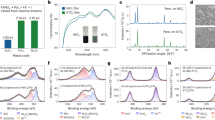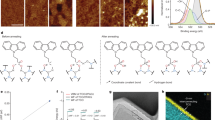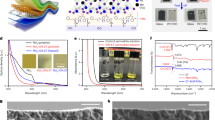Abstract
The efficiency of perovskite solar cells has recently been dramatically improved by a self-assembled monolayer (SAM), but forming uniform, dense and especially stable SAM remains a challenge. The hydroxyl groups on indium tin oxide (ITO) serve as the bonding sites for the SAM molecule, directly determining the distribution and anchoring stability of SAM. We developed a solution-based strategy to fully hydroxylate the ITO in as fast as 15 s. Moreover, further hydroxylation etching could also create abundant uncoordinated indium ions on the new exposed ITO surface for the anchoring of SAM by forming coordination bonds. In addition, the rapid hydroxylation etching allows commercial ITO to be directly used to omit the conventional multistep ITO pretreatment. Moreover, hydroxylation etching can also spontaneously form nano-antireflective structures on ITO to improve photon transmission. The versatile bonding site engineering resulted in better SAM anchoring, which delivered efficient perovskite solar cells (power conversion efficiency, 26.6%) that only lose 4% of the initial efficiency after 2,800 h of operation at 65 °C (ISOS-L-2 protocol).
This is a preview of subscription content, access via your institution
Access options
Access Nature and 54 other Nature Portfolio journals
Get Nature+, our best-value online-access subscription
$32.99 / 30 days
cancel any time
Subscribe to this journal
Receive 12 print issues and online access
$259.00 per year
only $21.58 per issue
Buy this article
- Purchase on SpringerLink
- Instant access to full article PDF
Prices may be subject to local taxes which are calculated during checkout




Similar content being viewed by others
Data availability
All data generated or analysed during this study are included in the Article and its Supplementary Information. Further data are available from the corresponding author (Q.Z.) on reasonable request.
References
Jiang, Q. et al. Towards linking lab and field lifetimes of perovskite solar cells. Nature 623, 313–318 (2023).
Liu, S. et al. Buried interface molecular hybrid for inverted perovskite solar cells. Nature 632, 536–542 (2024).
Wang, X. et al. Regulating phase homogeneity by self-assembled molecules for enhanced efficiency and stability of inverted perovskite solar cells. Nat. Photon. https://doi.org/10.1038/s41566-024-01531-x (2024).
Chen, H. et al. Improved charge extraction in inverted perovskite solar cells with dual-site-binding ligands. Science 384, 189–193 (2024).
Tan, Q. et al. Inverted perovskite solar cells using dimethylacridine-based dopants. Nature https://doi.org/10.1038/s41586-023-06207-0 (2023).
Azmi, R. et al. Double-side 2D/3D heterojunctions for inverted perovskite solar cells. Nature 628, 93–98 (2024).
Yu, S. et al. Homogenized NiOx nanoparticles for improved hole transport in inverted perovskite solar cells. Science 382, 1399–1404 (2023).
Li, C. et al. Rational design of Lewis base molecules for stable and efficient inverted perovskite solar cells. Science 379, 690–694 (2023).
Zheng, X. et al. Co-deposition of hole-selective contact and absorber for improving the processability of perovskite solar cells. Nat. Energy 8, 462–472 (2023).
Bardecker, J. A. et al. Self-assembled electroactive phosphonic acids on ITO: maximizing hole-injection in polymer light-emitting diodes. Adv. Funct. Mater. 18, 3964–3971 (2008).
Zhao, K. et al. peri-Fused polyaromatic molecular contacts for perovskite solar cells. Nature 632, 301–306 (2024).
Park, S. M. et al. Low-loss contacts on textured substrates for inverted perovskite solar cells. Nature 624, 289–294 (2023).
Zhao, Y., Luan, X., Han, L. & Wang, Y. Post-assembled alkylphosphonic acids for efficient and stable inverted perovskite solar cells. Adv. Funct. Mater. 34, 2405646 (2024).
Aydin, E. et al. Enhanced optoelectronic coupling for perovskite/silicon tandem solar cells. Nature 623, 732–738 (2023).
Lin, Y.-H. et al. Bandgap-universal passivation enables stable perovskite solar cells with low photovoltage loss. Science 384, 767–775 (2024).
Meng, H. et al. Inhibition of halide oxidation and deprotonation of organic cations with dimethylammonium formate for air-processed p–i–n perovskite solar cells. Nat. Energy 9, 536–547 (2024).
Xu, W. et al. Multifunctional entinostat enhances the mechanical robustness and efficiency of flexible perovskite solar cells and minimodules. Nat. Photon. 18, 379–387 (2024).
Chen, X. et al. Minimizing the buried interfacial energy loss using a fluorine-substituted small molecule for 25.92%-efficiency and stable inverted perovskite solar cells. Energy Environ. Sci. 17, 7342–7354 (2024).
Wang, W.-T. et al. Water- and heat-activated dynamic passivation for perovskite photovoltaics. Nature 632, 294–300 (2024).
Tang, H. et al. Reinforcing self-assembly of hole transport molecules for stable inverted perovskite solar cells. Science 383, 1236–1240 (2024).
Wu, M. et al. Reconstruction of the indium tin oxide surface enhances the adsorption of high-density self-assembled monolayer for perovskite/silicon tandem solar cells. Adv. Funct. Mater. 33, 2304708 (2023).
Armstrong, N. R. et al. Interface modification of ITO thin films: organic photovoltaic cells. Thin Solid Films 445, 342–352 (2003).
Donley, C. L. et al. Characterization of indium−tin oxide interfaces using X-ray photoelectron spectroscopy and redox processes of a chemisorbed probe molecule: effect of surface pretreatment conditions. Langmuir 18, 450–457 (2002).
Sun, J. et al. NiO-seeded self-assembled monolayers as highly hole-selective passivating contacts for efficient inverted perovskite solar cells. Sol. RRL 5, 2100663 (2021).
Hotchkiss, P. J. et al. The modification of indium tin oxide with phosphonic acids: mechanism of binding, tuning of surface properties, and potential for use in organic electronic applications. Acc. Chem. Res. 45, 337–346 (2012).
Donley, C. et al. Characterization of indium−tin oxide interfaces using X-ray photoelectron spectroscopy and redox processes of a chemisorbed probe molecule: effect of surface pretreatment conditions. Langmuir 18, 450–457 (2002).
Wei, Z. et al. Steering electron–hole migration pathways using oxygen vacancies in tungsten oxides to enhance their photocatalytic oxygen evolution performance. Angew. Chem. Int. Ed. 60, 8236–8242 (2021).
Liu, J. et al. Electron injection and defect passivation for high-efficiency mesoporous perovskite solar cells. Science 383, 1198–1204 (2024).
Vioux, A., Le Bideau, J., Mutin, P. H. & Leclercq, D. in New Aspects in Phosphorus Chemistry IV (ed. Majoral, J.-P.) 145–174 (Springer, 2004).
Phung, N. et al. Enhanced self-assembled monolayer surface coverage by ALD NiO in p-i-n perovskite solar cells. ACS Appl. Mater. Interfaces 14, 2166–2176 (2022).
Luo, C. et al. Engineering the buried interface in perovskite solar cells via lattice-matched electron transport layer. Nat. Photon. 17, 856–864 (2023).
Luo, C., Zhao, Y., Wang, X., Gao, F. & Zhao, Q. Self-induced type-I band alignment at surface grain boundaries for highly efficient and stable perovskite solar cells. Adv. Mater. 33, 2103231 (2021).
Ugur, E. et al. Carrier extraction from perovskite to polymeric charge transport layers probed by ultrafast transient absorption spectroscopy. J. Phys. Chem. Lett. 10, 6921–6928 (2019).
Ihly, R. et al. Efficient charge extraction and slow recombination in organic–inorganic perovskites capped with semiconducting single-walled carbon nanotubes. Energ. Environ. Sci. 9, 1439–1449 (2016).
Leng, J., Liu, J., Zhang, J. & Jin, S. Decoupling interfacial charge transfer from bulk diffusion unravels its intrinsic role for efficient charge extraction in perovskite solar cells. J. Phys. Chem. Lett. 7, 5056–5061 (2016).
Li, C., Zhang, N. & Gao, P. Lessons learned: how to report XPS data incorrectly about lead-halide perovskites. Mater. Chem. Front. 7, 3797–3802 (2023).
Liu, C. et al. Bimolecularly passivated interface enables efficient and stable inverted perovskite solar cells. Science 382, 810–815 (2023).
Luo, L. et al. Stabilization of 3D/2D perovskite heterostructures via inhibition of ion diffusion by cross-linked polymers for solar cells with improved performance. Nat. Energy 8, 294–303 (2023).
Gao, D. et al. Long-term stability in perovskite solar cells through atomic layer deposition of tin oxide. Science 386, 187–192 (2024).
Li, Z. et al. Stabilized hole-selective layer for high-performance inverted p-i-n perovskite solar cells. Science 382, 284–289 (2023).
Zhu, H. et al. In situ energetics modulation enables high-efficiency and stable inverted perovskite solar cells. Nat. Photon. https://doi.org/10.1038/s41566-024-01542-8 (2024).
Ahsani, M. & Yegani, R. Study on the fouling behavior of silica nanocomposite modified polypropylene membrane in purification of collagen protein. Chem. Eng. Res. Des. 102, 261–273 (2015).
Koh, K.-S., Chin, J., Chia, J. & Chiang, C.-L. Quantitative studies on PDMS-PDMS interface bonding with Piranha solution and its swelling effect. Micromachines 3, 427–441 (2012).
Al-Gharabli, S., Kujawa, J., Mavukkandy, M. O. & Arafat, H. A. Functional groups docking on PVDF membranes: novel Piranha approach. Eur. Polym. J. 96, 414–428 (2017).
Hohenberg, P. & Kohn, W. Inhomogeneous electron gas. Phys. Rev. 136, B864–B871 (1964).
Stephens, P. J., Devlin, F. J., Chabalowski, C. F. & Frisch, M. J. Ab initio calculation of vibrational absorption and circular dichroism spectra using density functional force fields. J. Phys. Chem. 98, 11623–11627 (1994).
Grimme, S. Semiempirical GGA-type density functional constructed with a long-range dispersion correction. J. Comput. Chem. 27, 1787–1799 (2006).
Ye, X. et al. Quantum chemical calculations for the H free radical chemisorption with different chain models during oil shale pyrolysis. Fuel 290, 119999 (2021).
VandeVondele, J. et al. Quickstep: fast and accurate density functional calculations using a mixed Gaussian and plane waves approach. Comput. Phys. Commun. 167, 103–128 (2005).
Kühne, T. D. et al. CP2K: an electronic structure and molecular dynamics software package—Quickstep: efficient and accurate electronic structure calculations. J. Chem. Phys. 152, 194103 (2020).
Lu, T. & Chen, F. Multiwfn: a multifunctional wavefunction analyzer. J. Comput. Chem. 33, 580–592 (2012).
Acknowledgements
We thank G. H. J. Zheng and X. Y. Gao from the Shanghai Synchrotron Radiation Facility for grazing-incidence wide‐angle X‐ray scattering measurements. We thank the BL14B1 beamline in the Shanghai Synchrotron Radiation Facility for providing the beam time. We thank Y. L. Wang from the Institute of Chemistry, Chinese Academy of Sciences, for water contact angle tests. We thank X. K. Zeng from Southwest Jiaotong University for the laser etching experiment. We thank Z. Wang and G. H. Wei for assistance with the preparation of the hydroxylation etching solution. This work was supported by the National Natural Science Foundation of China (NSFC 52272178 and 52473301), the National Key Research and Development Program of China (numbers 2023YFE0117700 and 2021YFB3800104), Beijing Nova Program (number 20230484415), the Young Elite Scientists Sponsorship Program by CAST, the Natural Science Foundation of Hubei Province (2022CFA093), the Natural Science Foundation of Jiangsu Province (BK20220244), Suzhou Basic Research Project (SJC2023003), the Natural Science Foundation of the Jiangsu Higher Education Institutions (22KJB480009), the China Postdoctoral Science Foundation (2024M751002 and GZC20240528) and Peking University-BHP Carbon and Climate Wei-Ming PhD Scholars (WM202201).
Author information
Authors and Affiliations
Contributions
C.L. and Q.Z. conceived the idea. Q.Z., Z.L. and Y.H. directed and supervised the project. C.L., Q.S.Z., K.W. and J.H. prepared the devices. C.L. and X.W. discussed the preparation of hydroxylation etching solutions. K.W. conducted the DFT calculations. C.Z., P.G. and Z.B. helped characterize the perovskite films and devices. Q.Z., Y.H. and C.L. co-wrote the paper. All authors analysed their data and reviewed and commented on the paper.
Corresponding authors
Ethics declarations
Competing interests
C.L. and Q.Z. have filed a provisional patent for this work with the China National Intellectual Property Administration. The other authors declare no competing interests.
Peer review
Peer review information
Nature Materials thanks Nam-Gyu Park and the other, anonymous, reviewer(s) for their contribution to the peer review of this work.
Additional information
Publisher’s note Springer Nature remains neutral with regard to jurisdictional claims in published maps and institutional affiliations.
Supplementary information
Supplementary Information
Supplementary Notes 1–4, Figs. 1–44 and Table 1.
Supplementary Video 1
Comparison of water contact angles between the control and target ITO.
Supplementary Video 2
One-shot recording of changing ITO from hydrophobic to superhydrophilic.
Supplementary Video 3
Fast hydroxylation of ITO in 15 s.
Rights and permissions
Springer Nature or its licensor (e.g. a society or other partner) holds exclusive rights to this article under a publishing agreement with the author(s) or other rightsholder(s); author self-archiving of the accepted manuscript version of this article is solely governed by the terms of such publishing agreement and applicable law.
About this article
Cite this article
Luo, C., Zhou, Q., Wang, K. et al. Engineering bonding sites enables uniform and robust self-assembled monolayer for stable perovskite solar cells. Nat. Mater. 24, 1265–1272 (2025). https://doi.org/10.1038/s41563-025-02275-x
Received:
Accepted:
Published:
Issue date:
DOI: https://doi.org/10.1038/s41563-025-02275-x
This article is cited by
-
Perovskite-based multi-junction solar cells
Nature Reviews Clean Technology (2025)
-
Engineered Hf0.7Ti0.3O2 nanoparticles for efficient radiotherapy on rectal cancer via synergistically enhanced radiation deposition and ROS production
Rare Metals (2025)



